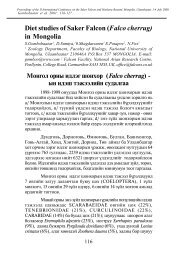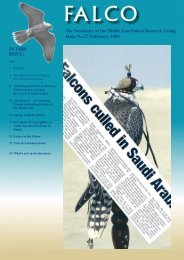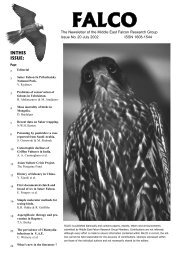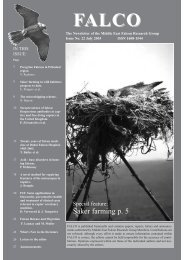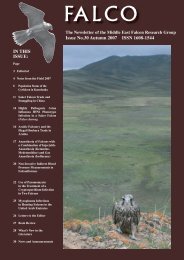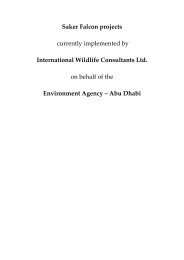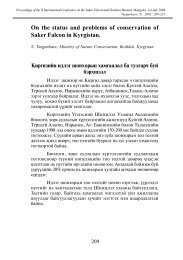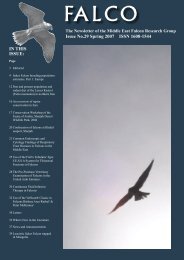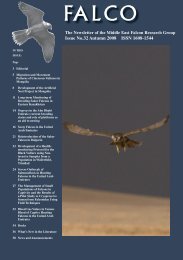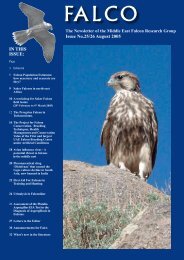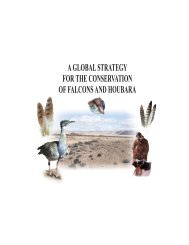Falco 28 - International Wildlife Consultants Ltd.
Falco 28 - International Wildlife Consultants Ltd.
Falco 28 - International Wildlife Consultants Ltd.
You also want an ePaper? Increase the reach of your titles
YUMPU automatically turns print PDFs into web optimized ePapers that Google loves.
item per day. The main food items were<br />
Jays (Garrulus glandarius) and to a lesser<br />
extent Crows (Corvus corone), Magpies<br />
(Pica pica), Rock Doves (Columba livia)<br />
and Blackbirds (Turdus merula) and<br />
occasionally Cuckoos (Cuculus canorus)<br />
and Chukar (Alectoris chukar). Our<br />
observations suggest that most prey was<br />
taken within 1.5 km of the nest, though we<br />
did see males on hunting flights travel up<br />
to 4 or 5 km away from the nest, whilst<br />
the females sometimes hunted in the<br />
immediate vicinity of the nest site.<br />
The young Peregrine <strong>Falco</strong>ns eave the nest<br />
in the last ten days of May; in 1997 the first<br />
fledgling was recorded on the 23 rd May<br />
and in 1998 on the 20 th May. The whole<br />
brood normally leave the nest within 2-4<br />
days of one another, indicating a degree<br />
of synchrony in their development. Once<br />
fledged, the brood stays near the nesting<br />
site and initially the young birds are poor<br />
flyers and seldom take to the air but by<br />
early June the fledglings can normally<br />
fly quite well. In early June the female<br />
appears to train the young to hunt by<br />
passing food to them in flight and forcing<br />
the fledglings to pursue her in order to get<br />
fed. We recorded broods with the adults<br />
at the nesting area until at least the end of<br />
July, so juvenile dispersal from the natal<br />
area occurs at a date later than this.<br />
Peregrine nesting cliff in Meghri District of<br />
Armenia<br />
On the 2 nd May 1997, we estimated age of a brood to<br />
be 15-16 days old, the chicks were covered with white<br />
down through which about 20 mm of feather growth<br />
had appeared from the wings, tail and back coverts.<br />
The colours of the feathers at this stage are ochreouschocolate<br />
with light ochreous-russet panels, whilst the<br />
colour of the bill, cere and feet is light bluish-grey. At<br />
the age of about 30 days the general colour of the upper<br />
side is ochreous-chocolate with light ochreous-russet<br />
feather panels, and the underside is roseous-ochreous<br />
with dark brown streaks. The ‘moustaches’ of dark<br />
chocolate-brown colour are expressed very well at this<br />
age and there is still a large amount of visible down on<br />
all the upper parts of the nestlings.<br />
Acknowledgements<br />
This is an update of an article that originally appeared in<br />
the journal “Vestnik MANEB 5 (17); 44-45” in Russian with<br />
an English summary. Adapted for <strong>Falco</strong> by Andrew Dixon<br />
from an original translation by Jevgeny Shergalin.<br />
References<br />
Adamian, M. and Klem D. Jr. 1999. Handbook of the Birds<br />
of Armenia. American University of Armenia, California.<br />
Dal, S. K. 1954. <strong>Wildlife</strong> of Armenia. Yerevan.<br />
Geilikman, B.O. 1987. Caucasian Peregrine <strong>Falco</strong>n. In the<br />
Red Data Book of Armenian SSR. Edited by S.O. Movsesyan<br />
and K.A. Airumyan. Yerevan “Aiastan”.<br />
During our observations we only saw the female feed<br />
the chicks and the role of the male was to provide food<br />
for the female, which she in turn then fed to the chicks.<br />
During the day we saw food brought to the nest 2-3<br />
times for a brood of three and 3-4 for a brood of 4; one<br />
average it appears that each chick got fed about one food



